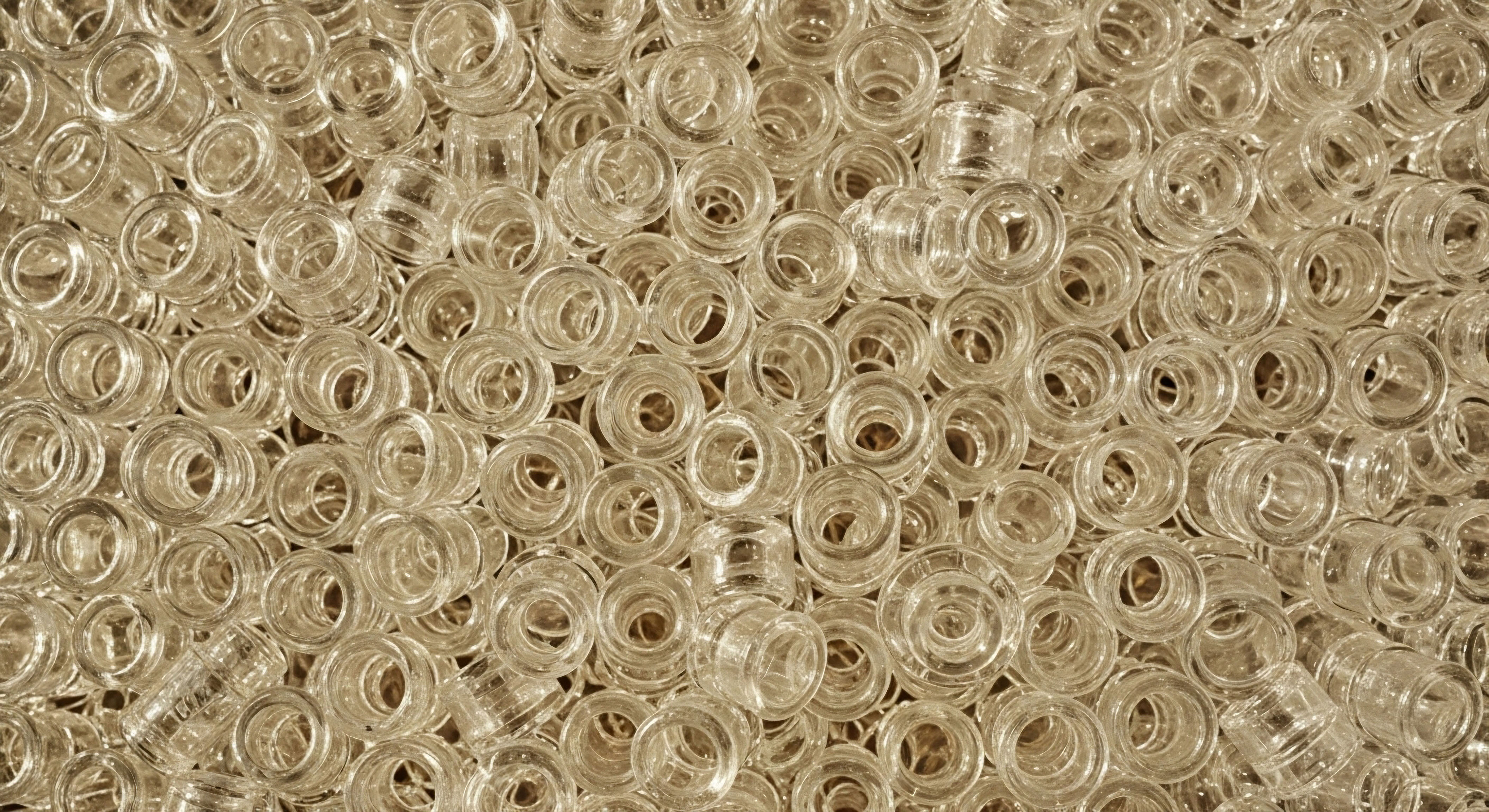

Fundamentals
You have completed a therapeutic cycle, a period of profound biochemical support designed to guide your body back toward an optimized state. Now, you stand at a new beginning, asking a perfectly logical question ∞ “How long must I continue with these lifestyle changes?” The answer lies in reframing the question itself.
The strategies you have learned ∞ the specific ways of eating, moving, sleeping, and managing stress ∞ were never intended to be a temporary scaffold. They are the essential architectural principles for building and maintaining a new, resilient version of your physiological self. Your treatment was the catalyst for change; these lifestyle protocols are the very structure of that change, designed to last a lifetime.
Think of your endocrine system as an intricate internal communication network. Hormones are the chemical messengers, carrying vital instructions from glands to target cells throughout your body. This network governs your energy, mood, metabolism, and vitality. Before your treatment, this system was likely compromised.
Perhaps the signals were weak, the receivers were insensitive, or the raw materials needed to create the messages were scarce. Your therapeutic protocol acted as a powerful external regulator, boosting the signals and ensuring the messages were delivered. It was a necessary intervention to restore function and remind your body of its optimal operating parameters.
Now that the external support is being withdrawn, the goal is for your internal systems to take over this regulatory function independently. This is where the lifestyle strategies become paramount. They are the tools you use to continuously support your body’s own innate intelligence.
They provide the raw materials for hormone production, ensure the communication pathways are clear, and keep the cellular machinery responsive to the messages being sent. This is a transition from passive reception of therapy to active stewardship of your own biology.

The Concept of Biological Stability
To understand why this commitment is ongoing, we must look at how the body maintains balance. For decades, the prevailing concept was homeostasis, the idea that the body strives to maintain a static, unchanging internal environment. While true to an extent, a more dynamic and accurate model is that of allostasis.
Allostasis means “stability through change.” It acknowledges that your body must constantly adapt to internal and external stressors ∞ a workout, a stressful deadline, a meal ∞ by adjusting its internal set points. For example, your blood pressure is not a fixed number; it rises during exercise and falls during rest, all in the service of meeting the body’s needs.
Chronic stress, poor nutrition, or lack of sleep push this adaptive system too far, leading to what is known as allostatic load. This is the cumulative “wear and tear” on your body from being forced to adapt to too many challenges without adequate recovery.
A high allostatic load is what often leads to the hormonal dysregulation that necessitated your treatment in the first place. Your treatment helped to reduce this load and reset the system. The lifestyle strategies you are now employing are designed to keep the allostatic load low, preventing a return to that state of biological crisis. They create a buffer, a reserve of resilience that allows your body to handle life’s stressors without compromising its core functions.
Post-treatment lifestyle strategies are not a temporary fix but a permanent commitment to providing your body with the resources it needs to maintain its own optimized hormonal balance.

The Four Pillars of Endocrine Support
Your daily choices in four key areas form the foundation of your long-term hormonal health. Each one provides critical inputs to the endocrine system, influencing how well it can self-regulate now that the direct therapeutic support has ended.
- Nutritional Protocols ∞ Your diet provides the literal building blocks for your hormones. Cholesterol and amino acids are the raw materials for steroid hormones like testosterone and peptide hormones. Micronutrients like zinc, magnesium, and B vitamins are essential cofactors in the enzymatic reactions that synthesize these hormones. A diet rich in nutrient-dense whole foods is a non-negotiable prerequisite for a healthy endocrine system. Processed foods, excess sugar, and industrial seed oils, conversely, can create inflammation and insulin resistance, which are profoundly disruptive to hormonal signaling.
- Movement And Exercise ∞ Physical activity is a powerful hormonal stimulus. Resistance training, in particular, sends a potent signal for the production of anabolic hormones like testosterone and growth hormone. It also improves insulin sensitivity, ensuring that your cells are more responsive to metabolic signals. The key is consistency and appropriateness. The right type and amount of exercise support the system, while excessive, under-recovered training can become another source of chronic stress, increasing allostatic load.
- Sleep And Circadian Rhythm ∞ The majority of your body’s hormonal regulation and cellular repair occurs during sleep. The pulsatile release of growth hormone, the regulation of cortisol, and the consolidation of memory are all governed by your sleep-wake cycle. Chronic sleep deprivation is one of the most direct ways to disrupt the Hypothalamic-Pituitary-Adrenal (HPA) axis, leading to cortisol dysregulation and a cascade of negative effects on downstream hormones. Aligning your life with a consistent circadian rhythm is a foundational act of hormonal self-care.
- Stress Modulation ∞ Your body’s stress response system, governed by the HPA axis and the hormone cortisol, is inextricably linked to your reproductive and metabolic hormones. Chronic activation of the stress response diverts resources away from functions like reproduction and repair. The body, perceiving a constant threat, prioritizes immediate survival over long-term health. Implementing practices like mindfulness, meditation, or even simple breathing exercises helps to downregulate this chronic stress response, allowing the Hypothalamic-Pituitary-Gonadal (HPG) axis to function without interference.
These four pillars are not separate interventions. They are a single, integrated system of inputs that collectively determine the environment in which your hormones operate. The question is not how long you need to focus on them, but rather how you can integrate them so seamlessly into your life that they become the new default.
This is the path to sustaining the benefits of your treatment and building a body that is resilient, optimized, and self-regulating for the decades to come.


Intermediate
Your journey through a therapeutic cycle has recalibrated your endocrine system, providing a window of opportunity for profound and lasting change. The question of how long to maintain your lifestyle strategies transitions here from a matter of duration to one of physiological purpose.
The objective is to solidify the gains from your protocol by fostering the independent, robust function of your body’s own regulatory systems, primarily the Hypothalamic-Pituitary-Gonadal (HPG) axis. This is a process of moving from assisted hormonal function to autonomous hormonal resilience. The lifestyle strategies are the very mechanisms by which you achieve this autonomy.
Following a protocol like Testosterone Replacement Therapy (TRT) or peptide therapy effectively creates an ideal hormonal environment through external inputs. For men on TRT, weekly injections of Testosterone Cypionate, often supported by Gonadorelin to maintain testicular function and Anastrozole to manage estrogen, establish consistent and optimal androgen levels.
For women, carefully dosed Testosterone Cypionate, Progesterone, or pellet therapy can restore balance and alleviate symptoms of perimenopause or menopause. Growth hormone peptides like Sermorelin or Ipamorelin work by stimulating the pituitary gland to release more of its own growth hormone. In all cases, the therapy provides a powerful, predictable signal.
The post-cycle period is about teaching your body to generate these optimal signals on its own. The lifestyle strategies are your tools for this education process. They directly influence the function of the hypothalamus and pituitary gland, the master regulators of your endocrine system.
By providing the correct inputs through nutrition, exercise, and stress management, you are supporting the health and sensitivity of these glands, enabling them to resume their natural, pulsatile signaling and maintain the balance that was previously supported by medication.

How Do Lifestyle Choices Directly Support the HPG Axis?
The HPG axis is the command-and-control center for your reproductive hormones. The hypothalamus releases Gonadotropin-Releasing Hormone (GnRH), which signals the pituitary to release Luteinizing Hormone (LH) and Follicle-Stimulating Hormone (FSH). LH then signals the gonads (testes in men, ovaries in women) to produce testosterone or estrogen. This is a delicate feedback loop. Your lifestyle choices are powerful modulators of this axis at every level.

Nutritional Architecture for Hormonal Production
Your diet is the foundational substrate for hormone synthesis. Sustaining your results requires a nutritional strategy that goes beyond simple calories and focuses on providing the specific precursors and cofactors for endocrine function.
- Macronutrient Sufficiency ∞ Adequate protein intake is essential for the structure of peptide hormones and the enzymes that synthesize all hormones. Healthy fats, including saturated and monounsaturated fats, are critical because cholesterol is the direct precursor to all steroid hormones, including testosterone and estrogen. Very low-fat diets can compromise the body’s ability to produce these vital molecules.
- Micronutrient Density ∞ Specific vitamins and minerals are indispensable for the enzymatic processes of steroidogenesis (hormone creation). Zinc, for instance, is crucial for LH release and testosterone production. Magnesium is involved in hundreds of enzymatic reactions and helps regulate the stress response. Vitamin D functions as a pro-hormone and is directly correlated with healthy testosterone levels. A diet lacking in these key micronutrients creates bottlenecks in the hormonal production line.
- Insulin Sensitivity ∞ High-sugar, high-carbohydrate diets can lead to chronic high insulin levels and insulin resistance. In men, high insulin can suppress LH production, directly impairing testosterone synthesis. In women, it can lead to an overproduction of androgens in the ovaries, contributing to conditions like PCOS. Maintaining insulin sensitivity through a diet rich in fiber and low in processed carbohydrates is essential for clear HPG axis signaling.

Exercise as an Endocrine Modulator
Physical activity is not just about burning calories; it is a potent form of hormonal communication. The type of exercise you perform sends different signals to the HPG axis and the rest of the endocrine system. A strategic combination is key to maintaining the balance achieved during therapy.
Strategic exercise selection provides the precise hormonal stimuli needed to encourage the body’s own production of anabolic and metabolic hormones.
| Exercise Type | Primary Hormonal Response | Mechanism of Action | Long-Term Goal Post-Treatment |
|---|---|---|---|
| Heavy Resistance Training (e.g. squats, deadlifts, presses) | Acute increase in Testosterone, Growth Hormone (GH), and IGF-1. | Activates a large amount of muscle mass, creating a systemic anabolic signal to the CNS and HPG axis. Improves neuromuscular efficiency. | To provide a regular, powerful stimulus for endogenous testosterone and GH production, maintaining muscle mass and metabolic rate. |
| High-Intensity Interval Training (HIIT) | Significant acute GH release; improved insulin sensitivity. | Creates a strong metabolic demand and cellular stress (hormesis) that upregulates mitochondrial function and glucose uptake. | To enhance cellular energy production and insulin sensitivity, making the body more responsive to all hormonal signals. |
| Steady-State Cardiovascular Exercise (e.g. jogging, cycling) | Improved cortisol regulation; enhanced cardiovascular efficiency. | Increases cardiac output and mitochondrial density in slow-twitch muscle fibers. Can lower resting heart rate and blood pressure. | To manage stress, improve cardiovascular health, and support recovery without over-taxing the HPA axis. |
| Mobility and Restorative Practices (e.g. yoga, stretching) | Downregulation of the sympathetic nervous system; reduction in cortisol. | Activates the parasympathetic (“rest and digest”) nervous system, promoting recovery and reducing the catabolic influence of chronic stress. | To actively manage allostatic load and prevent stress-induced suppression of the HPG axis. |

Cellular Allostatic Load and the Price of Poor Lifestyle
The concept of allostatic load can be extended to the cellular level. Every cell in your body must constantly adapt to its environment. When subjected to chronic inflammatory signals from a poor diet, excessive cortisol from unmanaged stress, or oxidative damage from overtraining, cells enter a state of high allostatic load. This has profound consequences for your endocrine system.
A cell under high allostatic load becomes less efficient. Its mitochondria, the cellular powerhouses, may become damaged, reducing the energy (ATP) available for essential functions. Hormone synthesis is an incredibly energy-intensive process. A cell that is struggling to produce enough energy to survive will not have the resources to build complex hormone molecules.
Furthermore, the receptors on the surface of that cell can become less sensitive to hormonal signals, a state known as receptor resistance. This means that even if you are producing enough hormones, your body cannot properly hear their messages.
Your lifestyle strategies are a direct intervention to lower this cellular allostatic load. A nutrient-dense, anti-inflammatory diet provides the necessary building blocks and reduces cellular stress. Proper sleep allows for cellular repair and detoxification. Stress management techniques reduce the toxic effects of chronic cortisol exposure.
These are not passive activities; they are an active process of creating an internal environment where your cells can thrive, produce ample energy, and remain exquisitely sensitive to hormonal signaling. This cellular health is the bedrock upon which sustained endocrine function is built, ensuring the benefits of your therapy become a permanent feature of your physiology.


Academic
The inquiry into the necessary duration of lifestyle interventions following a therapeutic hormonal cycle must be addressed from a perspective of systems biology and bioenergetics. The question transcends behavioral adherence and enters the domain of cellular physiology.
The ultimate goal of post-treatment strategies is to establish a new, resilient allostatic state, one that is maintained not by external pharmacological support, but by the intrinsic capacity of the body’s re-sensitized regulatory axes. This capacity is fundamentally dependent on the bioenergetic health of the organism, specifically the function of the mitochondrial network.
Therefore, the focus of long-term strategy is the perpetual optimization of mitochondrial function to support the energy-demanding processes of endocrine signaling and prevent the re-emergence of hormonal insufficiency.
Therapeutic interventions such as TRT or peptide therapies (e.g. Sermorelin/Ipamorelin blends) function by restoring signaling fidelity in a compromised system. They bypass points of failure, whether it is insufficient GnRH pulsatility from the hypothalamus, poor pituitary response, or inadequate gonadal output. However, the underlying cellular environment that contributed to this initial failure often remains.
The core of this failure is frequently a deficit in bioenergetic capacity. The hypothalamus, as a primary regulator of the HPG, HPA (Hypothalamic-Pituitary-Adrenal), and HPT (Hypothalamic-Pituitary-Thyroid) axes, is one of the most energy-demanding tissues in the body.
Its ability to maintain the precise, pulsatile release of signaling peptides like GnRH is directly coupled to its mitochondrial ATP production. A chronic state of low energy availability or high cellular stress creates what is termed “mitochondrial allostatic load” (MAL), a state where mitochondria undergo structural and functional recalibrations that are initially adaptive but ultimately become maladaptive, leading to reduced energetic output and increased production of reactive oxygen species (ROS).
This state of MAL is a primary driver of central endocrine suppression. When the hypothalamus lacks the requisite ATP to function optimally, it downregulates its signaling to conserve energy for more critical survival functions. This is a protective mechanism. The lifestyle strategies you employ post-treatment are therefore a form of metabolic and bioenergetic therapy aimed at reducing MAL and restoring the robust energetic capacity required for autonomous HPG axis function.

Mitochondrial Dynamics as the Engine of Endocrine Resilience
The persistence of your therapeutic gains is contingent upon creating an environment that fosters mitochondrial biogenesis, efficiency, and network integrity. Lifestyle interventions are the most powerful tools to modulate these processes at the molecular level.
- Nutrient Sensing Pathways and Mitochondrial Biogenesis ∞ Your dietary strategy directly influences key nutrient-sensing pathways like AMPK (AMP-activated protein kinase) and SIRT1 (Sirtuin 1). Caloric moderation and the cycling of macronutrients (e.g. periods of lower carbohydrate intake) can activate AMPK, the body’s master metabolic regulator. Activated AMPK signals a state of low energy, which in turn stimulates the expression of PGC-1α (Peroxisome proliferator-activated receptor-gamma coactivator 1-alpha). PGC-1α is the master regulator of mitochondrial biogenesis, initiating the creation of new, healthy mitochondria. This process effectively increases the energy-producing capacity of your cells, providing the hypothalamus and other endocrine tissues with the power they need.
- Hormesis and Mitochondrial Efficiency ∞ Hormesis is the principle that low doses of a stressor can elicit a beneficial, adaptive response. High-intensity exercise and exposure to cold or heat are potent hormetic stressors. These activities transiently increase ROS production within the mitochondria, which, counterintuitively, signals the cell to upregulate its own endogenous antioxidant defense systems (e.g. superoxide dismutase, glutathione peroxidase). This process, known as mitohormesis, leads to more resilient mitochondria that are more efficient at producing ATP with less oxidative byproduct. This enhanced efficiency is critical for sustaining the high energetic demands of constant endocrine signaling.
- Lipid Metabolism and Steroidogenesis ∞ The synthesis of steroid hormones is anchored within the mitochondria. The first and rate-limiting step of steroidogenesis is the transport of cholesterol from the outer to the inner mitochondrial membrane by the steroidogenic acute regulatory (StAR) protein. This process is highly energy-dependent. A lifestyle that supports mitochondrial health ∞ rich in specific fatty acids (e.g. omega-3s), low in inflammatory inputs, and supportive of insulin sensitivity ∞ directly enhances the efficiency of this foundational step in hormone production. Without healthy, energized mitochondria, the entire steroidogenic cascade is compromised at its source.
The lifelong application of targeted lifestyle strategies is a form of continuous bioenergetic therapy, aimed at maintaining the mitochondrial health required for autonomous endocrine function.

How Do Specific Therapies Interact with This Bioenergetic Model?
Peptide therapies, such as those involving Sermorelin and Ipamorelin, fit elegantly into this model. Sermorelin, an analogue of GHRH, and Ipamorelin, a ghrelin mimetic, both stimulate the pituitary to release growth hormone. This action is itself dependent on the energetic status of the pituitary somatotroph cells.
More importantly, the downstream effects of GH and its primary mediator, IGF-1, are profoundly anabolic and restorative at the cellular level. They promote protein synthesis and cellular repair, which helps to reduce the accumulated damage of past allostatic load.
In this context, a course of peptide therapy can be seen as a tool to help “reboot” the system and restore the health of target tissues, making them more responsive to the body’s own signals once the therapy is complete. The long-term maintenance of this restored sensitivity, however, falls back upon the bioenergetic support provided by lifestyle.
| Lifestyle Intervention | Primary Molecular Target | Cellular/Physiological Outcome | Relevance to Endocrine Autonomy |
|---|---|---|---|
| Intermittent Fasting / Caloric Moderation | AMPK, SIRT1, PGC-1α | Increased mitochondrial biogenesis; improved insulin sensitivity; enhanced autophagy (cellular cleaning). | Boosts the fundamental energy production capacity of the hypothalamus and pituitary, supporting robust GnRH/LH pulsatility. |
| Resistance Training | mTOR (mechanistic target of rapamycin), Androgen Receptor (AR) | Skeletal muscle hypertrophy; increased AR density and sensitivity; improved glucose disposal. | Maintains lean mass, which acts as a metabolic sink and endocrine organ, while enhancing the body’s responsiveness to endogenous testosterone. |
| Omega-3 Fatty Acid Supplementation | Membrane fluidity, resolution of inflammation (via resolvins/protectins) | Improved cell membrane structure and receptor function; reduced chronic low-grade inflammation. | Enhances the sensitivity of hormone receptors and reduces inflammatory signals that can suppress HPG axis function. |
| Consistent Sleep Schedule | Regulation of BMAL1/CLOCK genes (circadian rhythm) | Normalized cortisol nadir and peak; optimized pulsatile release of GH and LH; enhanced glymphatic clearance in the brain. | Synchronizes the entire endocrine orchestra, ensuring that hormonal signals are released at the appropriate time and in the appropriate amounts. |
In conclusion, the question of “how long” is answered by the nature of biological systems. The benefits of hormonal therapy are sustained by perpetually cultivating a state of high bioenergetic resilience. This is achieved through lifestyle strategies that directly target the molecular machinery of cellular energy production and signaling.
This commitment is not a temporary measure to prevent regression; it is the fundamental requirement for establishing and maintaining a new physiological paradigm of autonomous, optimized endocrine health. The work is lifelong because the biology it supports is lifelong.

References
- Picard, Martin, et al. “Cellular allostatic load is linked to increased energy expenditure and accelerated biological aging.” Nature Metabolism, vol. 3, no. 10, 2021, pp. 1383-1399.
- Hackney, Anthony C. “Exercise, Training, and the Hypothalamic-Pituitary-Gonadal Axis in Men and Women.” Endocrine and Interventional Radiology, edited by S. Karger AG, 2016, pp. 28-39.
- Kraemer, William J. and Nicholas A. Ratamess. “Hormonal responses and adaptations to resistance exercise and training.” Sports Medicine, vol. 35, no. 4, 2005, pp. 339-361.
- McEwen, Bruce S. “Stress, adaptation, and disease ∞ Allostasis and allostatic load.” Annals of the New York Academy of Sciences, vol. 840, no. 1, 1998, pp. 33-44.
- Corpas, E. S. M. Harman, and M. R. Blackman. “Human growth hormone and human aging.” Endocrine Reviews, vol. 14, no. 1, 1993, pp. 20-39.
- Raastad, T. et al. “Hormonal responses to high- and moderate-intensity strength exercise.” European Journal of Applied Physiology, vol. 82, no. 1-2, 2000, pp. 121-128.
- Sigalos, J. T. & Zito, P. M. “Sermorelin.” StatPearls, StatPearls Publishing, 2023.
- Veldhuis, J. D. et al. “Testosterone and estradiol regulate secretion of growth hormone, each via a different non-classical signaling pathway.” Reviews in Endocrine and Metabolic Disorders, vol. 9, no. 1, 2008, pp. 43-51.
- Sterling, Peter, and Joseph Eyer. “Allostasis ∞ a new paradigm to explain arousal pathology.” Handbook of life stress, cognition and health, edited by S. Fisher and J. Reason, John Wiley & Sons, 1988, pp. 629-649.
- Walker, R. F. “Sermorelin ∞ a better approach to management of adult-onset growth hormone insufficiency?” Clinical Interventions in Aging, vol. 1, no. 4, 2006, pp. 307-308.

Reflection
You have now explored the deep biological reasons why your lifestyle strategies are an ongoing commitment. The knowledge that your daily choices directly influence the energy of your cells, the clarity of your hormonal signals, and the resilience of your entire system is powerful.
This understanding moves you from the position of a patient following instructions to the role of an informed architect of your own physiology. The path forward is one of continuous learning and self-awareness. How does your body respond to different nutritional approaches? What type of movement leaves you feeling energized and strong?
How can you structure your days to honor your natural circadian rhythm? Your therapeutic cycle opened a door to a new level of function. The knowledge you have gained is the key to keeping that door open, allowing you to build upon this foundation for the rest of your life. The ultimate goal is a partnership with your own body, one built on a foundation of scientific understanding and profound self-respect.



